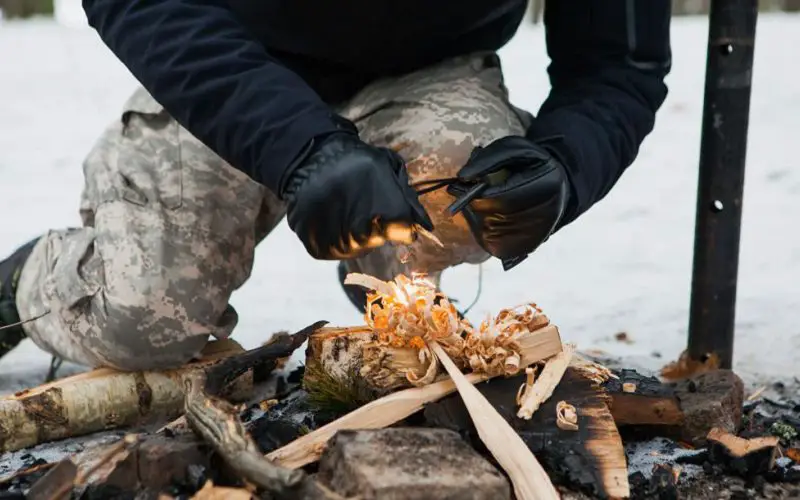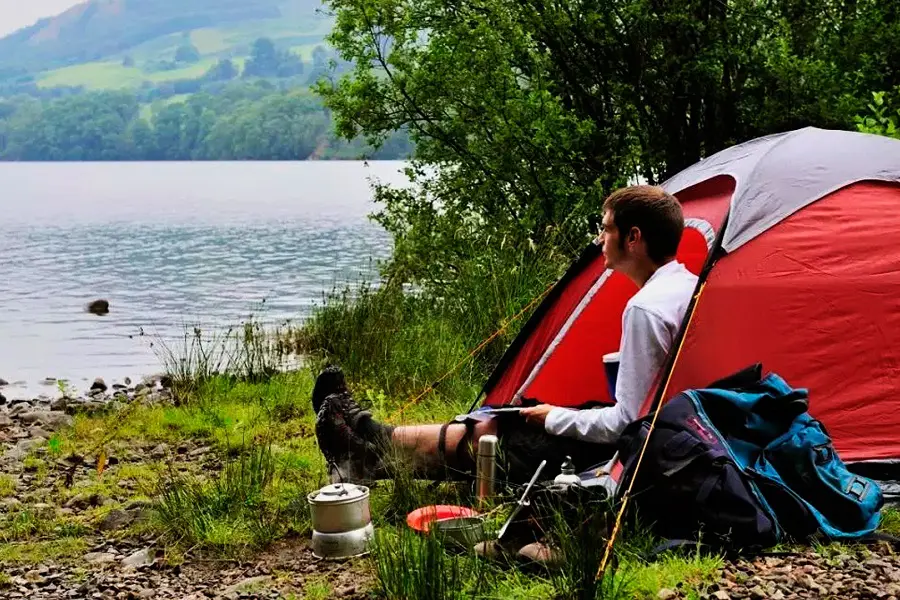SHTFPreparedness may collect a share of sales or other compensation from the links on this page.
Everyone enjoys camping, but abandoned campsites not only harm future campers but also contribute to environmental harm. We’re already doing enough of that on a daily basis.
In addition to preserving the natural resources you wish to enjoy, leaving no trace while camping helps you avoid fines and citations from parks and campgrounds.
Leaving behind a slightly ruined campsite can lead to hundreds (sometimes thousands, depending on how well the person filing the fine knows local law) of dollars in fines, which is just absurd.
When you factor that into your trip’s total cost, it can become quite overwhelming. Let these no-trace camping tips ease your mind and avoid all that.
6 Important Leave No Trace Principles When Camping
1. Create Smaller Campfires

Smaller campfires leave virtually no trace behind.
In most scenarios, you can pack up your tent and belongings, drag away your backpack, and see a fairly clear campsite, except for that pile of soot and ashes you left from the night before.
We won’t dispute the difficulty of cleaning up campfires, but maintenance is still necessary. Starting small will leave you with less to clean up. Which one of these things do you always do after camping late at night?
Think about putting out a fire before bed, but what if there was none? Smaller campfires obviously last for a lot less time, but that can actually benefit you immensely. When you leave the campsite, there’s wet soot that stains the earth.
Use your shovel to dig up a very thin layer of dirt beneath your roasted tinder, and place that (along with the burned firewood remnants) into a bag that you can toss into a nearby garbage can, or put in the car and dispose of at home.
Some campgrounds have a firewood disposal in their main office, so check before camping.
2. Leave Everything How You Found It
This is one of those things that sounds so obvious and basic, but don’t worry, we’re going to describe how to get it done.
The second you show up to your campsite, use your phone and take a photograph in broad daylight. You’ll get a glimpse of where everything is and what it should look like when you leave.
After setting up a grill, tent, sleeping bags, and other camping essentials, we tend to throw this little perfect patch of nature into disarray.
Bucket-style tent floors can create odd patches in the dirt; perhaps we moved the brush around to make things more comfortable for us. Put it all back in its proper place.
One way to leave everything as you found it is simply to not use a hammock while you’re camping. If you stake your hammock into the tree, you’re damaging it.
If you’re using a tight rope around it and putting more than 300 lbs of pressure in the hammock (you and a partner, perhaps), then it’s going to dig into the bark and damage it either way.
Move twigs and brush back to their original locations, and make sure to leave no trace behind.
3. Bring Your Own Portable Waste Containers
If you’ve ever had the thought, “This isn’t going to make an impact” or “Nobody will notice,” it’s quite the opposite.
Bring your own waste containers with you and return them when you leave. If you place that waste in your home trash cans, it will still end up in a landfill, but it’s preferable to directly dump it into a national park or preserved area.
Furthermore, it helps to avoid paying fines and fees. You can also do on-site dumping at designated areas, but in some places, that could mean increased fees.
If you’re already paying for trash service at home, there’s no point in additional charges. If you’re not crazy about lugging home three days worth of garbage with you, you’re not alone.
You can purchase large trunk-style plastic containers in the automotive section of most Walmarts or your own 27-gallon trash bins and seal them so you don’t whiff that nasty stuff on the car ride home.
Grab odor-sealed trash bags or double-wall them.
4. Use Eco-Friendly Materials When Available
Eco-friendly camping materials prevent an environmental impact before you even set foot on the campsite.
You can be confident that when tents, sleeping bags, and other necessities eventually end up in landfills, they will decompose rather than worsening the global impact.
You can also use environmentally friendly materials to start a campfire if you’re in an area that doesn’t require you to purchase firewood.
As long as you do it, any environmentally friendly idea is good.
5. Do an Equipment Check on Your Gear
Be sure to check your bags, backpacks, and everything else for tears or missing parts.
Leaving behind scraps of man-made materials can cause an animal to choke, litter the campsite, and disturb a site.
Ensure you have accounted for all the small pieces if you have taken anything apart for cleaning or repairs. This form of eco-friendly camping doesn’t sound like much.
What can a scrap of a tent patch accomplish? It’s going to leave your scent on it, which will cause animals to stay away from the area.
That’s a disturbing nature, and the goal is to leave with as little of an impact as possible so that the wildlife can still enjoy that part of the forest after you’ve left.
6. Closing Tips
There are right and wrong ways to bury human waste. If you’re doing dispersed camping and there’s no nearby restroom, you need to be careful with how you take care of waste.
Bury it away from the campsite and as deep down as possible. If you don’t, you’re going to leave a “mark” on the campsite that will prevent animals from traveling to or near it.
If you don’t need the extra space, don’t take it. Even for larger parties, making a smaller campsite minimizes the amount of disturbance to wildlife. This also means there’s less to clean up in the end, which mitigates how long it takes to store the campsite.
In the spirit of leaving as little a mark as possible, stick to known or common hiking trails and avoid trekking into the woods where animals might be.
Common hiking trails typically don’t attract much wildlife, so creating new pathways through the forest could potentially scare away the local animals.
Avoid using accelerants on your campfire. Even if it’s late and you’re trying to get it going, that sends a chemical odor into the air, which could damage plant life and scare off wildlife. Accelerants can soak into the ground, leaving patches of dead soil that make it nearly impossible for new plant life to root in.
There’s nothing wrong with that; just don’t get too close to or disturb bird nests. That goes for all wildlife. If you spot anything traveling in the woods, keep your distance. This is good for your own safety, as well as keeping normal wildlife living zones undisturbed.
If you’re not going solo, have the other party member(s) check the campsite when you’re leaving to ensure you didn’t forget anything. Two sets of eyes are always better than one.
When you spend one to three hours packing up gear appropriately, it’s not uncommon for some things to fall by the wayside. After packing everything, make a quick check to ensure everything is in order.
Wrap-Up
This information will help you avoid fines, conserve nature, and be a more responsible camper.
Even if you think you’ve got it all figured out, take the time to peer through, ensure that there are no lapses in your campsite knowledge, and walk away, leaving it in the exact condition you found it in.
















